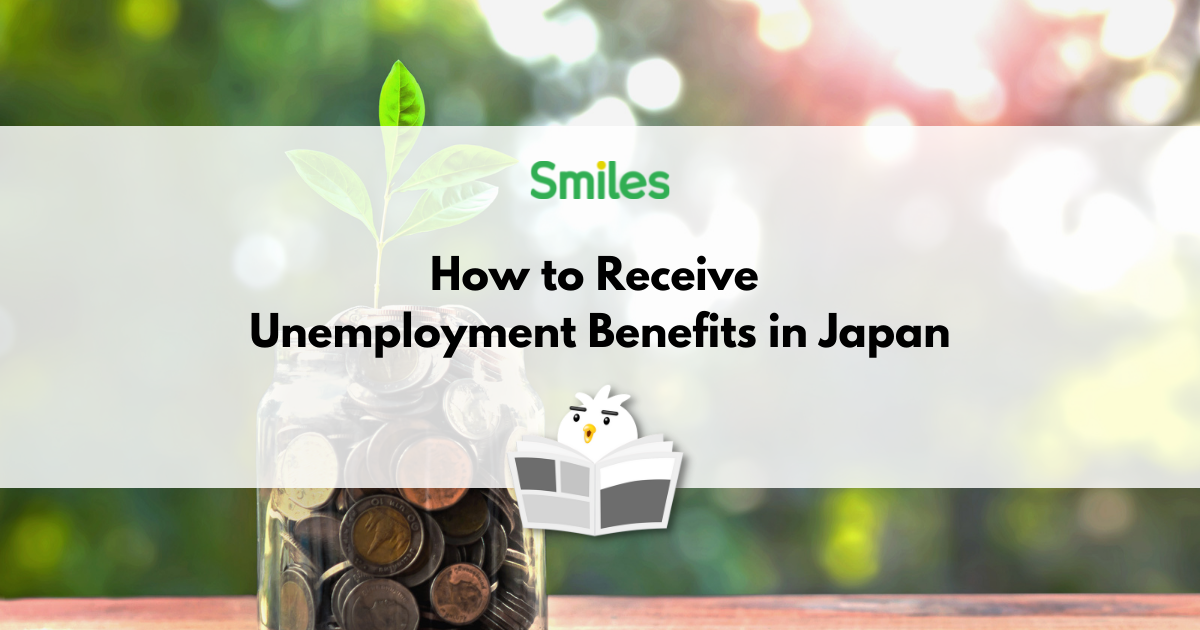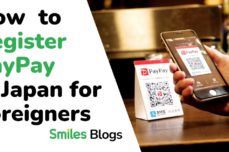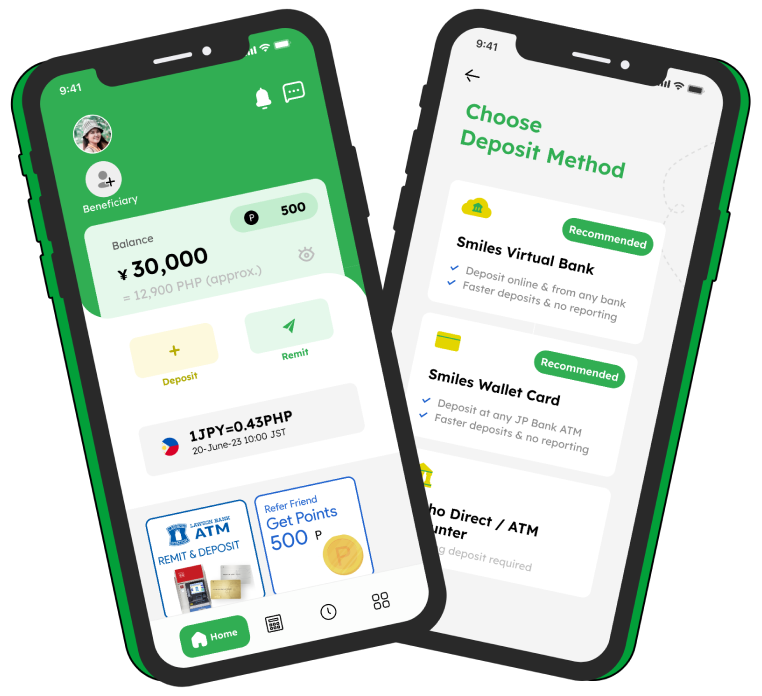
How to Receive Unemployment Benefits in Japan
Work
Unemployment benefits in Japan are offered to people who have been unemployed by either the company or employees themselves. Benefits not only apply to Japanese workers but also to foreign workers. In this blog, Smiles will show you how to apply for unemployment benefits in Japan, but before you give it a read, take a look at the list of Japanese words related to the topic:
Unemployment benefit – 失業給付金 (shitsugyou kyuufukin)
General allowance – 基本手当 (kihonteate)
Unemployment insurance – 雇用保険 (koyouhoken)
Involuntary resignation – 会社都合退職 (kaishatsugou taishoku)
Voluntary resignation – 自己都合退職 (jikotsugou taishoku)
General benefit per day – 基本手当日額 (kihon teate nichigaku)
Re-employment allowance – 再就職手当 (saishushoku teate)
Personal identification number – 個人番号 (kojinbango)
Table of Contents
1. What are Japan’s unemployment benefits?
Japan’s unemployment benefits are subsidies that the Japanese government grants to workers who have lost their jobs and are in a state of unemployment. The general allowance for unemployment insurance is given to those who fall under one of the two objects below:

Further into the blog, Smiles will guide you on how to confirm eligibility and apply for Japan’s unemployment benefits for object 1. For object 2, Smiles invites you to refer to the following instructions for applying for an extension of unemployment benefits:
Instructions for applying for an extension of unemployment benefits
2. Eligibility to receive unemployment benefits in Japan
Note:
- If the number of working days is 11 days or more, or the basic working time is 80 hours or more, that time will be rounded to 1 month
- Employees with short-term contracts (20 to 30 hours/week) must have at least 12 full months of working 11 days or more
3. Required documents for unemployment benefits in Japan
The documents that are required in order to carry out the procedures include the following:
- Job severance information sheet for employment insurance (issued by the company at the time of leaving)
- Residence card
- Certificate of receiving unemployment insurance (given by the company before leaving work)
- 2 portrait photos (3×2.5 cm): New photo with front-upper half of the body shown and 3.0 cm by 2.5 cm dimensions
- Personal seal (if you have one)
- Account book or bank card with applicant’s name on it
- My Number Card*
*If you do not have a My Number Card, bring the following additional documents:
- Juminhyo residence certificate with personal identification number
- Identity document such as a driver’s license, driving history certificate, identity card, diploma (scanned copy) issued by the competent authority, National Health Insurance Card or certificate of allowance for child support
4. Details of unemployment benefits in Japan
4.1 Determining the cause of leave
First, the employee needs to determine the reason for leaving the job.
Involuntary resignation:
Involuntary resignation is a case where the employee is forced to quit by the employer, not from the employee themselves. The common causes of resigning are:
- The company went bankrupt
- The employee is dismissed due to personnel restructuring in the enterprise
- The employee reaches retirement age
- The company’s business situation (e.g., changing business orientation)
Voluntary resignation:
Voluntary resignation is when the employee themselves makes their decision to leave their employment. The common reasons for leaving are:
- Changing jobs
- Marriage
- Long-term illness
- Violating the company’s regulations and being dismissed
- Note: It can be difficult to determine whether the reason for dismissal is reasonable or not. Therefore, many employees feel unconvinced with the dismissal decision, so they apply for benefits with the reason of leaving the company.
Please note that it’s very important to determine which type of resignation causes unemployment, as it affects the wait time for benefits, the number of benefits to be received and the time to receive benefits.
4.2 Number of days employees receive unemployment benefits
The wait time to receive benefits will be based on the cause of unemployment, the applicant’s age and time of participating in unemployment insurance.
In the case of involuntary resignation

In the case of voluntary resignation
There are two groups of applicants:
- Those who have no serious illnesses: the number of days to receive benefits is generally prescribed based on the number of years of participating in unemployment insurance.
- Those who have a disability or have difficulties applying for jobs: the number of days to receive benefits is divided into milestones based on age and number of years of insurance participation, specifically as follows:

The time to be able to receive unemployment benefits is only about a year from the date of resignation. However, the period of receiving benefits can be extended if they fall into one of the following categories:
- Women who are pregnant, giving birth or raising children (under 3 years old)
- Employee receiving unemployment benefits and is having health problems (e.g., injury, illness, or disease)
- Employee receiving unemployment benefits and is taking care of family members
- Going abroad (for a volunteering event or following his/her wife/ husband to work abroad)
To extend the period of the benefit, you will need to follow procedures, go to Hello Work to discuss more details or refer here [chart in #2].
4.3 Formula for calculating the amount of benefit
The formula for calculating the total unemployment benefit is calculated as general benefit per day multiplied by the number of days received (based on the content in section 4.2).
1-day allowance = (total salary of 6 mon. before leaving job) ÷ 180 x (coefficient: 50 to 80%)
The coefficient will be determined according to each person’s income. Thus, those with a low base salary have a higher rate of allowance. For people who are 60 to 64 years old, the coefficient will range from 45 to 80%.
Note: The amount of one-day allowance that does not exceed a certain level is as follows:

5. Application process for unemployment benefit in Japan
As soon as you are unemployed, we advise you to submit an application for Japan’s unemployment benefit.

The application process for Japan’s unemployment benefit is as follows:
Step 1: Register for a job at Hello Work
At Hello Work, you will need to fill in the information on a new job application form and submit the necessary documents. Then, your application will be checked to make sure you are eligible for the unemployment benefit.
Step 2: Attend an introduction seminar for Japan’s unemployment benefits
If you are notified that you are eligible to apply for unemployment benefits, you will be guided to attend an introduction seminar. At the end of the seminar, you will receive a certificate of eligibility for unemployment benefits as well as an unemployment certificate. If you don’t participate, you won’t be subsidized.
Step 3: Receive the unemployment certificate
Every four weeks (28 days) from the date of joining the introduction seminar, you must go to Hello Work to confirm your unemployment status. During this time, you must demonstrate you are actively participating in job search activities at least two times per month, such as attending career counseling sessions or receiving job recommendations at Hello Work’s counseling counter.
Step 4: Receive unemployment benefits
Within five days from the date of being unemployed, the allowance will be transferred to your registered bank account. Please remember that during the unemployment period, you will still need to get your unemployment status confirmed monthly at Hello Work and demonstrate your active job search efforts until you return to work or until the unemployment benefit period expires.
Please note that the unemployment benefit period will be up to a total of one year. However, if your unemployment period is longer than that one-year subsidized period limit, you are not eligible for the continuation of receiving the unemployment benefit.
During the one-year benefit period, if you commit fraudulent acts (e.g., fraudulently declaring your job loss, not participating in job search activities or not declaring you are working even though you are working part-time) you will not only lose your eligibility to receive the benefit, but you will also have to repay the benefits received along with a penalty of two times the amount received.
So you may be wondering what if I find a new job during the benefit period? What if I find a new job while I’m receiving unemployment benefits?
Workers will receive a special benefit called “re-employment allowance”, which is equivalent to 30% of the full unemployment benefit.
The conditions for receiving the re-employment allowance may be a little complicated. An example would include the remaining days being from one-third of the total number of days receiving the benefit and being 45 days or more along with some other conditions. Fortunately, the amount received is not small, so if you meet the conditions, please contact Hello Work.
We hope the instructions and information for unemployment benefits in Japan were helpful. Of course, there is a possibility that you won’t get anything, but it may be worth a try as the process is not too complicated. Currently, COVID-19 has made life much more difficult for many people. Finding a job is no longer as easy as before. So, even if it’s just a small opportunity, take advantage of it. Smiles wishes you the best!
Related Articles:
Getting Married in Japan can Give you 600,000 JPY Grant
10 Easy Steps on How to use My Number Card at Combini Printers




























